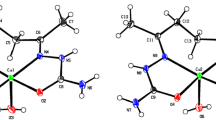Abstract
The crystals of [C9H7N(C3H5)]2CuIICl4(IV) were obtained through ac electrochemical synthesis using CuCl2· 2H2O, N-allylquinolinium chloride, and copper electrodes in an ethanol-benzene medium. These crystals transformed with time into crystals of the [C9H7N(C3H5)][CuIICl3(C9H7N)] complex (V). When tin(II) chloride was added to the initial reagents, the [C9H7N(C3H5)]CuI 2Cl3complex (VI) was obtained. The X-ray diffraction analysis (DARCh-1 autodiffractometer, MoK αradiation, Zr filter) indicated that complexes IVand Vcrystallize in the triclinic system: space group P \(\overline {\text{1}} \); for IV, a= 12.817(4), b= 10.435(3), c= 9.606(3) Å, α = 97.94(2)°, β = 107.28(2)°, γ = 95.99(2)°, V= 1200.6(6) Å3, Z= 2; for V, a= 16.992(5), b= 8.243(2), c= 7.345(3) Å, α = 91.89(3)°, β = 91.19(3)°, γ = 88.18(3)°, V= 1027.5(6) Å3, Z= 2. Crystals VIare monoclinic, space group P21/n, a= 13.578(5), b= 15.079(4), c= 6.953(4) Å, β = 105.08(4)°, V= 1370.6(10) Å3, Z= 4. Structures IV–VIconsist of N-allylquinolinium cations and different anions: isolated [CuCl4]2–tetrahedrons (IV), [C9H7NCuCl3]–tetrahedrons (V) containing a quinoline molecule, and a polymer chain |[CuI 4Cl6]2–} n (VI) in which two independent metal atoms have trigonal-pyramidal and planar-trigonal environments. The C=C bond of the allyl group is not involved in cooordination with the Cu(I) atom.
Similar content being viewed by others
REFERENCES
Mys'kiv, M.G., Fayad, Kh., and Zavodnik, V.E., Metalloorg. Khim., 1991, vol. 4, no. 2, p. 415.
Oliinik, V.V. and Mys'kiv, M.G., Koord. Khim., 1996, vol. 22, no. 11, p. 876.
Mys'kiv, M.G. and Oliinik, V.V., Koord. Khim., 1995, vol. 21, no. 4, p. 290.
Goreshnik, E.A., Pavlyuk, A.V., Shollmeier, D., and Mys'kiv, M.G., Koord. Khim., 1999, vol. 25, no. 4, p. 699.
Goreshnik, E.A., Shollmeyer, D., Mys'kiv, M.G., and Pavl'uk, O.V., Z. Anorg. Allg. Chem., 2000, vol. 626, no. 4, p. 1016.
Goreshnik, E.A., Davydov, V.N., Pavlyuk, A.V., and Mys'kiv, M.G., Koord. Khim., 1999, vol. 25, no. 10, p. 784.
Mykhalichko, B.M. and Mys'kiv, M.G, Ukraine Patent UA 25450A, Byull., 1998, no. 6.
Akselrud, L.G., Grin, Yu., Pecharsky, V.K., et al., Trans. Tech. Pub., 1993, part 1, p. 335.
Sheldrick, G.M., SHELXL97: Program for Refinement of Crystal Structures, Göttingen: Univ. of Göttingen, 1997.
Choi, M.-G. and Angelici, R.J., Acta Crystallogr., Sect. C: Cryst. Struct. Commun., 2000, vol. 56, no. 5, p. 808.
Author information
Authors and Affiliations
Rights and permissions
About this article
Cite this article
Pavlyuk, A.V., Davydov, V.N. & Mys'kiv, M.G. Synthesis and Structure of Complexes Formed in the CuCl2–Cu–N-allylquinolinium Chloride System. Russian Journal of Coordination Chemistry 27, 865–870 (2001). https://doi.org/10.1023/A:1013065129446
Issue Date:
DOI: https://doi.org/10.1023/A:1013065129446




